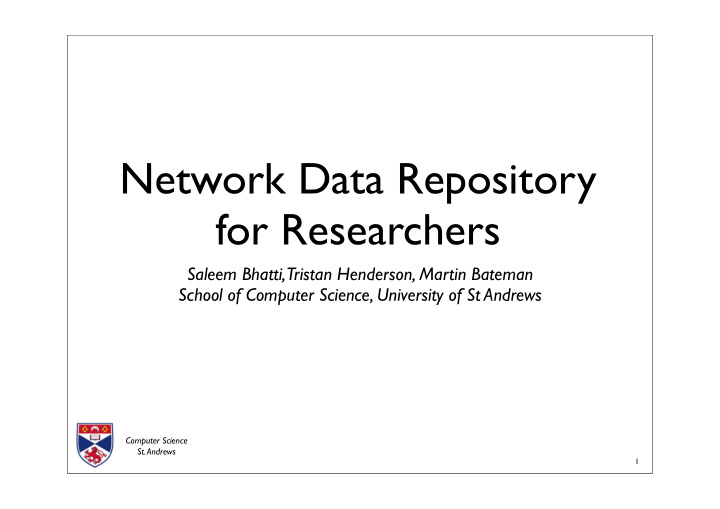



Network Data Repository for Researchers Saleem Bhatti, Tristan Henderson, Martin Bateman School of Computer Science, University of St Andrews Computer Science St. Andrews 1
Outline of talk 1. Outline of how to get started 2. What we have set up at St Andrews 3. CRAWDAD mirror 4. Questions 5. (Demo after talk) Computer Science St. Andrews 2
Gathering network data • Researchers are increasingly eager to test their ideas by taking measurements. • UKERNA support for data capture becoming available. • Sharing of data: • network traces, data used for papers. • reproducibility of results. • (applies to simulation studies too.) Computer Science St. Andrews 3
Instrumentation and measurement • Internet Measurement Masterclass in Cambridge, Dec 2006 - how to get started. • However, it can take a long time to undertake: • sys/net admin interaction and agreement. • clarify legal aspects. • Sys/net admins often reluctant to engage due to: • lack of previous experience of such activity. • insufficient knowledge of legal ramifications. Computer Science St. Andrews 4
Local agreement • Research Use of Network Traffic Data: http://www.ja.net/development/traffic-data/ • Policy + SLA. • MASTS project (UKLIGHT monitoring) • Can be used locally: • local variant in use at St Andrews. • plus some additional guidelines agreed locally. • (will make available end of Aug 2007) Computer Science St. Andrews 5
What you need to do 1. Define what data you need: • Unlikely to need full packet dumps. 2. Start talking to your sys/net admin staff: • Be patient ... these folk have a day job. 3. Ensure data users are briefed on DPA: • Ignorance is no defence. 4. Have a well-defined data distribution system: • Keep track of who uses data. Computer Science St. Andrews 6
St Andrews agreement • A modified version of the UKERNA document: • plus four Annexes 1. List of users 2. List of administrators 3. Guidelines for producing publications 4. Guidelines for using data Computer Science St. Andrews 7
Outline of talk 1. Outline of how to get started 2. Example of what we have set up 3. CRAWDAD mirror 4. Questions 5. (Demo after talk) Computer Science St. Andrews 8
Process User User requests downloads Trace File Trace User Request is queued User notified that File is ready Trace File is Sanatised/ Anonymised Computer Science St. Andrews 9
Outline architecture Logging service metadata queue queue Web Cluster cache Storage Server cache Storage Server datafile pull datafile push web services application WS-Notifications email im Status notification queue Notification service Computer Science St. Andrews 10
Outline of talk 1. Outline of how we got started 2. Outline of what we have set up 3. CRAWDAD mirror 4. Questions 5. (Demo - after talk) Computer Science St. Andrews 11
RAWDAD http://CRAWDAD.cs.dartmouth.edu Community Resource for Archiving Wireless Data At Dartmouth Researchers in wireless networks CRAWDAD is an NSF-funded need data to project to build a wireless understand real network usage identify the real problems network data archive for the evaluate possible solutions research community. CRAWDAD provides Currently (March 2007), 598 users from 365 institutions around the Archive of wireless-network traces world 802.11, MANET, VANET, Sensor network, 23 data sets DTN, location, etc. 12 tools Tools for trace collection 70 papers collect, process, sanitize, analyze, etc Staff: HOWTO documents in wiki full-time programmer plus 2 undergrads Support for the research community Event calendar Bibliography Specialist groups (MANET, Education) Annual Workshop (free!) Contact: crawdad@cs.dartmouth.edu Hosted by Center for Mobile Computing at Dartmouth College Computer Science St. Andrews 12
Example: Dartmouth campus 802.11 WLAN • Dartmouth campus, 500-1500 access points • 6 years of mobility traces • location = access point • 2 detailed (3-4 month) packet traces • layer 2-4 • Used by over 200 researchers • mobility modelling, DTN, security, routing Computer Science St. Andrews 13
Daily WLAN Users (April 11, 2007) Computer Science St. Andrews 14
Questions, queries, comments ... Computer Science St. Andrews 15
Outline of talk 1. Outline of how to get started 2. Example of what we have set up 3. CRAWDAD mirror 4. Questions 5. (Demo after talk) Computer Science St. Andrews 16
Computer Science St. Andrews 17
Computer Science St. Andrews 18
Computer Science St. Andrews 19
Computer Science St. Andrews 20
Computer Science St. Andrews 21
Computer Science St. Andrews 22
Computer Science St. Andrews 23
Computer Science St. Andrews 24
Recommend
More recommend